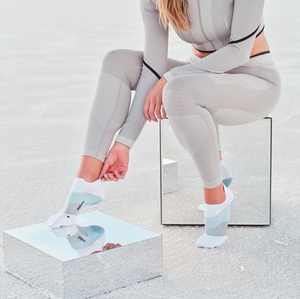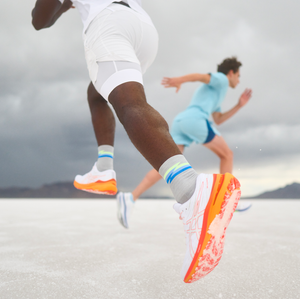Spring and fall running means preparing for large temperature swings. As spring turns into summer, it can be hard to get your body adjusted to running in the heat. These simple tips can improve your running in spring, summer, or anytime you have to adapt to hot-weather running.
There are four steps every runner should follow to adjust to running in the heat:
- Layer Up
- Learn your heart rate zones
- Hydrate
- Plan accordingly
Now let’s explore these hot weather running tips in more detail.
Wear Layers to Run in Warming Temperatures
Hot weather running isn’t just about staying cool during the hottest parts of the day; a warm afternoon often starts with a cool morning. Running in late spring or fall means adapting to big temperature swings in many parts of the country. Layering your running attire allows you to adjust your body temperature as air temps rise or fall.
For cool starts, I like to plan to run a warm-up mile or two near my car and then ditch my outerwear in my car before continuing on. Other runners wear a range of light layers, while some people simply dress for the warmest hour of their run and try not to freeze beforehand.
Socks are an important part of your running clothes for hot weather. Feetures Merino running socks keep your feet cool when it's warm and warm when it's cold. They wick moisture, too, making them a perfect alternative to cotton if you’re looking for an anti-blister sock.
Monitor Your Heart Rate When Running in the Heat
If you’re like me, you’ve probably found yourself flying along in the winter at paces you couldn’t dream of in the summer, accompanied by a low heartrate and a feeling of ease, only to be knocked down a peg when the temperatures warm up.
It takes time for our bodies to acclimate to running in hot weather. It’s helpful to learn your heart rate zones and adjust your pace accordingly while your body gets used to the heat. Check out these heart rate zone monitoring tips from Runners World. Run smart on hot days and you’ll be running faster longer.
Hydrate While Running on Hot Days and Cold Days ‘
Many runners only take hydration seriously when running during summer. As the weather heats up in the spring, though, the air is often still dry, meaning dehydration is accelerated without being as obvious. You’ll want to increase your fluid intake over your winter levels to support your body as it works harder in the warmer weather. But let’s be clear: You need to stay hydrated while running in cold weather, too – don’t let cool temps fool you.
Have a Training Plan and Race Plan for Hot Weather Runs
One of the most challenging aspects of training for a spring race is how different race conditions can be from training conditions. After running all winter, your body is used to cold weather and may need to acclimate to running in the heat when spring arrives.
Avoid a bad race day by making sure your long runs mirror race conditions to the extent possible. If you’re running a race later in the spring or in a warm climate, consider doing a portion of your long training runs during the warmest part of the day. If it’s cold where you live, hop on the treadmill for a portion of your run to acclimate to warm temperature running.



Leave a comment